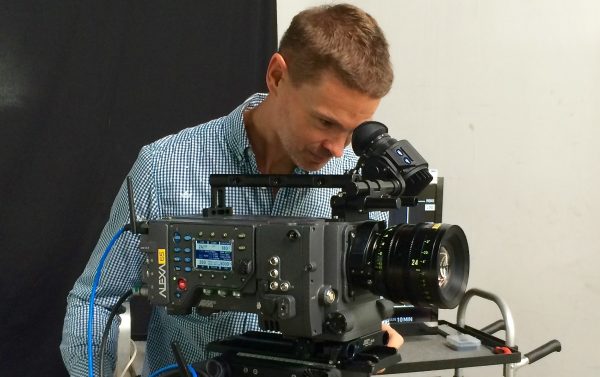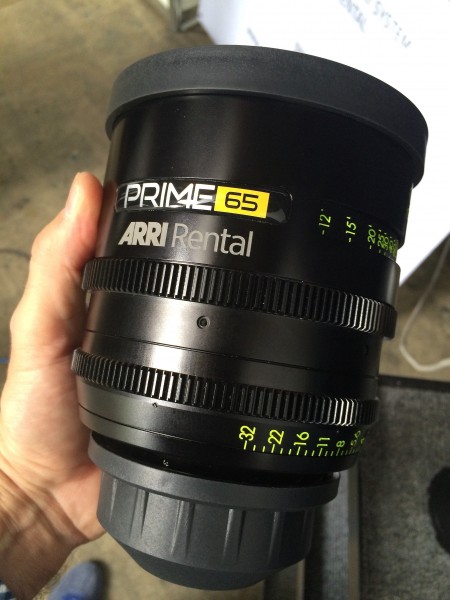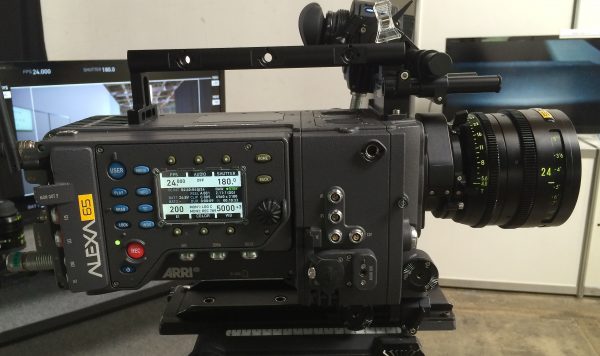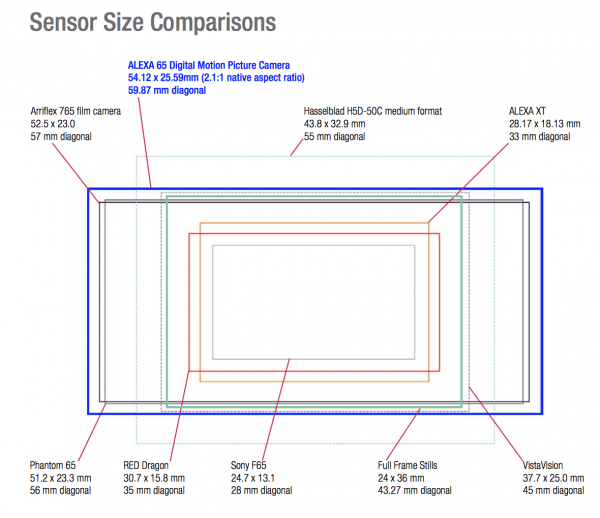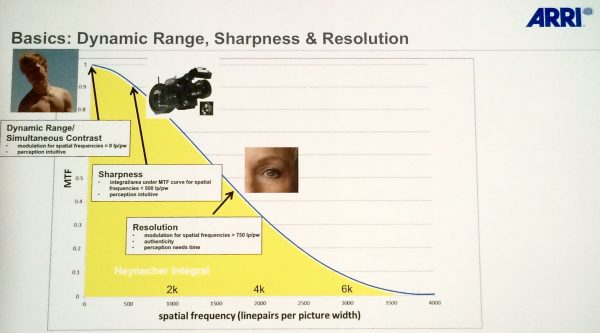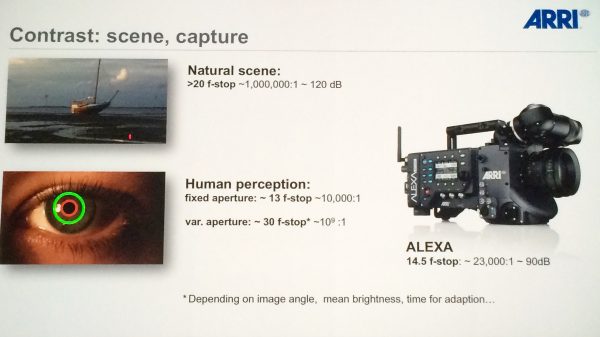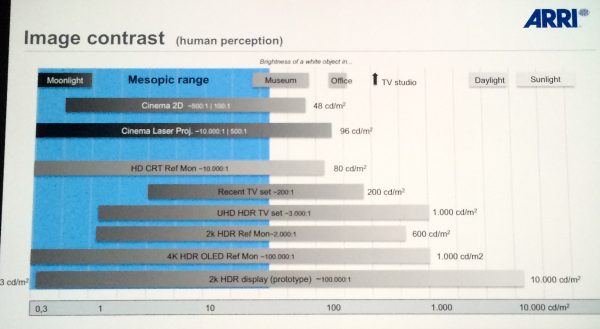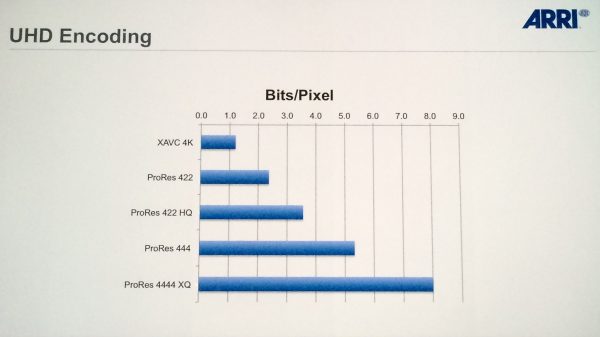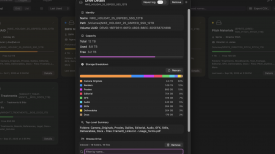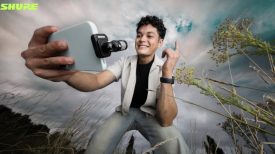By technical editor Matt Allard:
The Alexa 65 is a pure motion picture camera. It is targeted at blockbuster movie production with a rental price to match. Even though I may never get to actually use this camera for a real production, it is interesting to look at this high end technology and where it might take us all in the future. 6K and super large sensors may be unaffordable for most right now – but in a few years, who knows?
I recently had the chance to talk at length with Franz Kraus, Managing Director of ARRI. At a private event hosted by NAC Image Technology in Japan he gave me his fascinating insights into resolution, colour science and the new ARRI Alexa 65. The Alexa 65 cine camera, with its giant 6K sensor, was on display along with the latest anamorphic lenses.
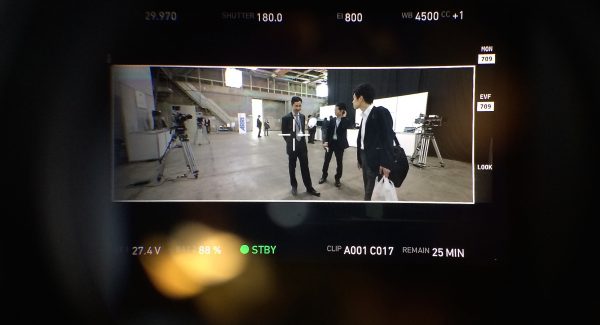
Kraus explained that a lot of design consideration has gone into how the Alexa 65 represents human faces. It was important to make faces look pleasing, whether young or old. They did not want the ultra-high resolution of the camera to make faces look harsh or unnatural. From the footage I saw, it looks like they have managed to keep that famously beautiful Alexa skin colour rendition despite the extra added resolution.
The Alexa 65 has been introduced 20 years after the company first released the ARRI 765 65mm film camera. According to the company there are currently 28 Alexa 65s and the camera I saw in Japan was one of a handful that weren’t out on a major production. One of the first movies to shoot on the Arri 65 is the Zhang Yimou movie The Great Wall, shot by Oscar-nominated cinematographer Stuart Dryburgh. The film is set to be the largest film ever shot entirely in China for global distribution. The film stars Matt Damon, Willem Dafoe, Game of Thrones actor Pedro Pascal and a host of Chinese actors. The Oliver Stone movie Snowden is also shooting on it, and Emmanuel Lubezki is shooting Alejandro G Inarritu’s The Revenant with the camera.
Cinematographer Robert Elswit also shot an underwater sequence for Mission Impossible 5 on the camera and Greig Fraser is using it to film parts of Star Wars spin-off Rogue One. If that list of movies isn’t already impressive enough, there are plans to use it for Captain America: Civil War, which is set to be released in IMAX format. ARRI and IMAX are working together to add additional hardware and software to the Alexa 65 technology to create a camera designed specifically for the format.
It was fun to be able to get my hands on the camera. I spent half an hour going through all the menu options and getting a feel for what it would be like to use. Anyone who is familiar with the Alexa will be right at home with this camera as the operation and menus are very similar. This should make slotting it into a feature film environment very easy.
I also got to try out some of the new prime lenses for the 65 made with Hasselblad. These share optics with medium format stills lenses, but are constructed for cine use.
There was a chance to watch ARRI 65 demonstration material on a huge 4K DCP compliant screen inside a theatre on the Toei Movie Studios lot. It is one thing to watch footage from the camera on a YouTube trailer, but it is something else completely when it is projected in 4K. It looked simply stunning on the big screen.
Even if you do have incredibly deep pockets and want to rent the camera (it isn’t available for purchase) – good luck: there is a long waiting list. It has been a real hit with big studio movies.The rental price is around 4250 Euros/day ($4600US) and that is just for the camera body.
Given that ARRI have consistently argued that their 3.2K sensor on the Alexa is better than enough to satisfy movie going audiences in regular theatres, you may well think that ARRI hasn’t really been interested in increased resolution. According to Kraus this couldn’t be further from the truth. ARRI are going there, but he said there are a lot of other elements that need to be taken into consideration in the move to higher and higher capture resolutions. Kraus’s view was that it isn’t just resolution that counts and that ARRI are trying to create a more immersive perception.
He said: “The first item, without any question, is enhanced resolution. The second is definition for capturing and displaying fine detail to capture more authentic images and to avoid aliasing. The third is capturing higher frame rates for capturing and portraying image detail without causing motion blur. The last thing is extended dynamic range for capturing and re-creating real-world-like images.”
Above is a slide from the ARRI presentation showing an ARRI 65 MTF/spatial frequency chart. The readings are from a combination of the camera, lenses, optical low pass filter, sensor and image processing. It may appear complex but demonstrates that perceived image fidelity is not simply about resolution. At first glance, when objects are moving or appear only very briefly, your eye cannot perceive the difference between a 1K and a 4K image. For fine detail to be resolved at higher resolutions, your eye needs time to rest on the image. If the image is moving or cut too quickly the extra resolution cannot be perceived. Kraus pointed out that only if you had perfect sight and were sitting in the first two rows of the theatre we were in could you actually enjoy the benefits of 4K. Anyone sitting further back would not be able to perceive the difference in resolution. To get the benefit of 4K at home you either need to be sitting very close to the screen or have a very large 4K TV.
According to ARRI, if you are filming in 2K or 4K at 24 frames per second with a 180 degree shutter angle (1/48th of a second) and the camera is moving quickly, the amount of motion blur means the image will look the same in 2K as it does at 4K. The only way to perceive a difference between 2K and 4K when the camera is moving is to use a higher frame rate and shutter speed – with less resulting motion blur. ARRI maintain that if you want to have higher resolution for motion pictures where objects are moving and the camera is moving, then you need to use higher frame rates for capture and display to see a difference. Within the industry, the jury still seems to be out on whether HFR material still looks at all like film and whether strobing artifact effects are needed for it to retain its film look. Kraus told me he was aware of the ongoing debate but added that if we don’t move to higher frame rates, then we need to end up with images that are more static, or forget about higher resolutions altogether.
US Broadcast TV is moving forward with 60P as the standard and this makes a lot of sense. 4K TV transmission is done in the REC.2020 colour space that is only compliant with progressive frame rates and not interlaced. 24 or 30P would not be options as the amount of motion blur would make sports events almost unwatchable. There are now digital cinema projectors that are capable of 120 progressive frames per second, so the technology is in place, but the question remains: will the aesthetics be accepted by directors, the industry, and most importantly the audience? Peter Jackson’s Hobbit use of 48fps was not deemed to be a big success – half the audience liked it and half hated it. Kraus suggests trying a solution that is perhaps a little controversial – exceeding the 48fps and going significantly higher.
Kraus stressed that one of the most important things to ARRI remains dynamic range and the ability to capture real world contrast and colour. Maintaining a real world grey scale and colour, while providing headroom for exposure variations is at the forefront of ARRI’s thinking. A natural scene not looking directly into the sun has around 20 stops of dynamic range. The human eye can apparently see around 13 stops of dynamic range at a fixed aperture, and up to 30 stops at a variable aperture when our eyes are allowed to rest and adjust to our surroundings. The ARRI Alexa currently offers 14.5 stops of dynamic range and Kraus was quick to point out that there is still room for improvement. For fixed aperture conditions he says the ARRI cameras cope very well, but in terms of real world contrast, improvement is possible and needed.
Even though higher resolution is one of the key selling points of the latest ARRI technology, Kraus seemed more excited about the coming of HDR displays and projectors that are able to show a wide dynamic range. “What is the purpose of a high dynamic range camera if there are no high dynamic range displays? While the cameras offer more headroom in post production, the real beauty comes when you exceed the screen brightness by providing additional contrast.” Kraus also said that anyone who has seen one of the new HDR screens is immediately convinced of its advantages. As far as Kraus is concerned, HDR is definitely here to stay.
If you took a regular piece of paper and exposed it to moonlight you would get a reading of about 0.3 candela per square meter. If you exposed that same piece of paper to bright sunlight you would get a reading of 10,000 candela per square meter. Prototype 2K HDR displays will be able to display image contrast from moonlight all the way to bright sunlight. In a real world situation like a movie theatre the contrast levels are always going to be compromised. The light from the screen bounces onto the audience, the audience members who are wearing light colours will then bounce that light back onto the screen and so on. Even so, a HDR projection should still have a great advantage over conventional technologies.
ARRI are quick to point out that the goal is to not always portray the images at maximum brightness level, even on a HDR display. The goal is always to maintain headroom. For example, if there is candlelight and the candlelight is prominent, or there are headlights of a car going towards the camera, you need to allow for headroom to cope with things like reflections.
ARRl also talked about data compression and codecs during their presentation. They realise that for economical and practical reasons data compression is generally used in acquisition and transmission, but they stressed that people should be aware of the consequences and impact; applying too much data compression to an image can greatly effect your end footage. That’s why, in the case of the Alexa 65, it captures uncompressed RAW images for optimal imagery.
ARRI still uses the now long-in-the-tooth Apple ProRes codecs to compress their footage in camera, but they showed some examples comparing Sony’s newer 4K XAVC to ProRes UHD compression. The slides showed more artifacts in the XAVC image when compared to ProRes (but, in fairness, the XAVC codec is recording material at a lot lower data rate). To truly see the benefit of 4K you need four times the amount of data to capture the same level of quality per pixel as you would in 2K. With manufacturers under pressure to reduce file sizes they often apply higher data compression and unfortunately reduce the per pixel resolution as a consiquence. So through over compression you effectively lose some of the resolution you gained by going to 4K in the first place.
In movie theatres with 2K or 4K DCP projection, JPEG 2000 compression is used and the maximum bit rate is 250 Mb/s regardless of whether it is 2K or 4K. According to ARRI, this compression removes a lot of detail from the original image, and is apparent when watching 4K DCP. Again, their point is that the high resolution and high detail images you work very hard to capture in 4K are degraded by compression in the movie theatre. ARRI’s opinion is that 4K DCP compression needs to be increased to around 1Gb/s to not see any noticeable loss in resolution or detail.
Kraus closed his presentation by saying that audiences sitting very close to large screens will undoubtably benefit from high resolutions, but only if less data compression is applied. Higher resolution requires significantly higher capture frame rates in anything but static shots, and there aren’t a lot of static shots in most of today’s movies. He concluded by saying that the dominating factor in perceived image quality is screen brightness along with screen contrast, where the entire audience benefits regardless of where they sit, how big the screen is and what genre the film is. For future HDR screenings the camera needs to be able to exceed the screen’s capabilities to avoid noise and the clipping of highlights.

